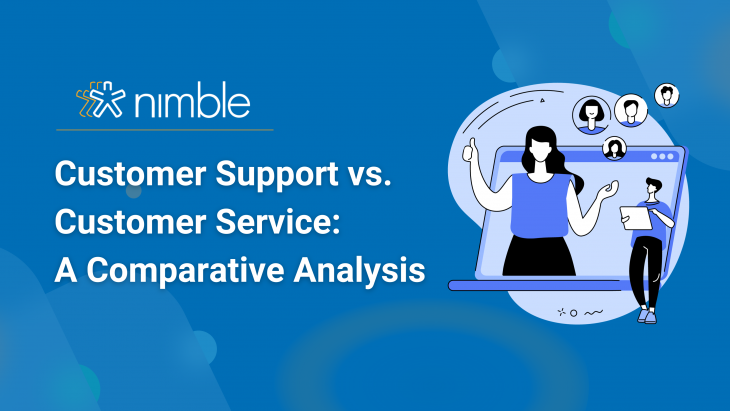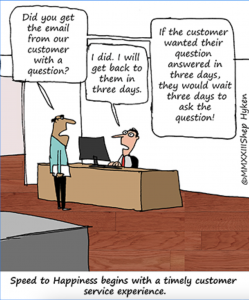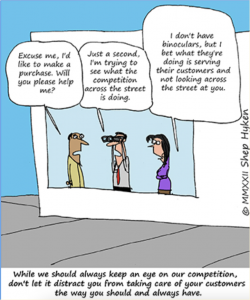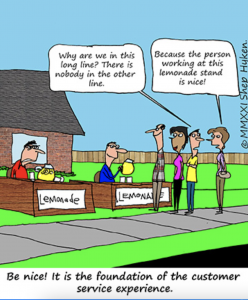In the realm of customer-focused business strategies, the terms “customer support” and “customer service” are often used interchangeably. After all, both are dedicated to assisting customers and ensuring a positive experience. In fact, “95% of consumers say customer service impacts their brand loyalty, naming easy access, self-service, and professional agents as important factors” (NICE).
However, there are subtle yet crucial differences between the two, and understanding these distinctions can impact your business’s success. In this blog post, we will embark on a comparative analysis of customer support and customer service to unravel the nuances and uncover their importance in the modern business landscape.
Understanding Customer Support
At its core, customer support is a specialized service offered by businesses to assist customers in resolving specific issues or concerns. It acts as a direct bridge between the customer and the company, focusing on addressing individual needs and providing solutions. Whether it’s troubleshooting technical problems, offering guidance, or responding to inquiries, customer support is the frontline of customer assistance.
The Role of Customer Support in Business
Customer support plays a multifaceted role within a business. Its primary functions include:
- Issue Resolution: It’s the go-to resource for customers when they encounter problems or face challenges with a product or service. Customer support agents are trained to efficiently address and resolve these issues.
- Technical Assistance: Customers often seek help with technical aspects, from setting up a device to configuring software. Customer support teams are well-versed in providing the necessary guidance.
- Customer Education: Customer support also educates users on how to make the most of the product or service. This involves explaining features, sharing tips, and ensuring customers have a comprehensive understanding.
- Inquiry Handling: It’s not just about problems; customer support handles general inquiries too. Whether customers have questions about their account, billing, or product specifications, customer support is the place to turn.
A shining example of effective customer support can be found in the world of technology with Apple Inc. Apple’s customer support is renowned for its dedication to resolving customer issues promptly and efficiently. They provide a range of support options, including phone support, online chat, and in-person assistance at Apple Stores.
What sets Apple’s customer support apart is its commitment to providing personalized solutions. Their support agents are not just troubleshooting experts; they are empathetic, patient, and skilled at guiding customers through technical issues with a focus on customer satisfaction. This approach has not only garnered trust but also helped in building a loyal customer base that appreciates the extra mile Apple goes to ensure its customers’ needs are met.
Understanding Customer Service
At its core, customer service represents the entire spectrum of interactions and touchpoints that a business has with its customers. It’s not limited to resolving issues or answering inquiries; it extends to every phase of the customer journey, including marketing, sales, onboarding, and post-purchase care.
Customer service aims to create a positive and memorable experience for customers, ensuring their needs are met at every stage. It’s a holistic approach to customer satisfaction that prioritizes building relationships and delivering exceptional value.
The Role of Customer Service in Business
The role of customer service is far-reaching, as it impacts various facets of business operations:
- Creating Positive Customer Experiences: Beyond issue resolution, customer service is responsible for crafting experiences that leave a lasting impression. This extends from the first interaction, such as marketing and advertising, to the final stage, encompassing post-purchase support.
- Driving Customer Loyalty: Exceptional customer service is a potent driver of customer loyalty. By consistently exceeding customer expectations and offering personalized assistance, businesses can cultivate a loyal customer base that keeps returning.
- Influence on Brand Image and Reputation: A business’s brand image and reputation are intricately tied to the quality of its customer service. Positive customer experiences contribute to a favorable public perception and brand reputation.
- Financial Considerations: While achieving excellence in customer service may require investments in staff training, technology, and process improvements, these investments often result in long-term financial benefits through increased customer retention, word-of-mouth marketing, and repeat business.
Amazon Prime is a prime example (pun intended) of customer-centric innovation. Amazon Prime members enjoy perks such as fast, free shipping, exclusive access to entertainment content, and early access to deals. This membership program enhances customer loyalty and incentivizes customers to return to Amazon for their shopping needs.
Amazon’s relentless commitment to customer service excellence has led to not only a large, loyal customer base but also a reputation for being customer-focused and trustworthy. The company’s ability to create a seamless, personalized, and hassle-free shopping experience is a prime illustration of how superior customer service can drive success in today’s competitive business landscape.
Bridging the Gap: A Deep Dive into Customer Support vs. Customer Service
Discovering Common Ground: The Overlapping Worlds of Customer Service and Support
In examining customer support and service, several core similarities emerge. Both prioritize a customer-centric approach, aiming to meet needs, resolve issues, and create positive experiences. Effective communication skills are integral, enabling clear technical solutions and a seamless journey. Feedback utilization informs their improvement strategies, enhancing the overall customer experience. Both functions play a pivotal role in shaping a company’s brand image and reputation, with customer service focusing on long-term loyalty and customer support preventing customer attrition due to unresolved issues. Continuous improvement is essential, driven by changing customer preferences and technological advancements.
Unveiling Distinctions: Customer Support vs. Customer Service
Distinguishing customer support from customer service, we find that customer support primarily targets issue resolution and technical assistance, while customer service aims for a holistic, positive customer experience.
Customer support employs direct communication channels and operates during set hours, focusing on specific metrics like response time and issue resolution. In contrast, customer service embraces indirect channels, remains available 24/7, and measures success using broader KPIs like customer satisfaction and loyalty.
Staff roles vary, with customer support focusing on technical problem-solving and customer service requiring a wider skill set, including sales and relationship-building. Lastly, customer expectations differ: customer support prioritizes swift issue resolution, while customer service aims for consistent satisfaction throughout the customer journey. These distinctions guide businesses in striking a balance between these two functions to create an exceptional customer experience.
Takeaways for Harmonizing the Customer Experience
In the realm of customer service and support, there are important insights to consider in order to enhance the customer experience. By achieving the right equilibrium between addressing specific issues and cultivating an overall positive experience is crucial.
Furthermore, it’s vital to recognize that every interaction with a customer contributes to their perception of your brand, making each interaction an opportunity to leave a positive impression. Embracing change and adapting to evolving customer preferences and technological advancements is a shared necessity for both customer service and support.
Ultimately, the objective is to develop a strategy that revolves around the customer, capitalizing on the strengths of both customer support and service. This approach guarantees satisfied and content customers in the ever-evolving landscape of customer service and support.




